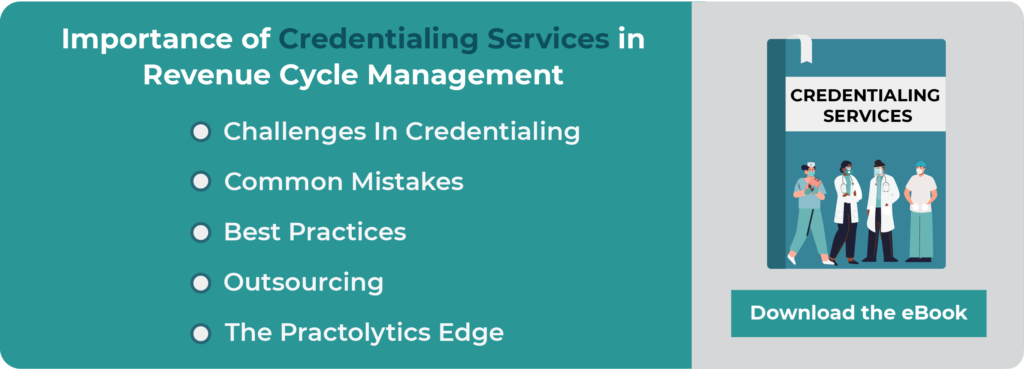New Physician Credentialing Timing Is Everything
You should celebrate when a new doctor accepts to join your practice. It represents expansion, better patient care, and a bright future. However, amidst the excitement, a critical administrative reality quickly sets in: new physician credentialing timing is everything. This often-underestimated process is the single most significant factor determining when your new doctor can start seeing patients, billing for services, and contributing to your revenue cycle. In the world of healthcare, when it comes to new physician’s credentialing checklist, timing truly is everything.
Delaying or mismanaging the credentialing process for a new hire is not merely an administrative oversight; it’s a direct blow to your practice’s financial health, patient access, and even the new physician’s early satisfaction.
Table of Contents
The Unseen Costs of Credentialing Delays
Imagine a new physician credentialing software starting on July 1st, but their credentialing applications aren’t fully processed and approved by key payers until October 1st. What happens in those three months?
- Lost Revenue: For every day the physician is not credentialed with a major payer, your practice cannot bill for their services to that payer’s patients. Since many payers will not retrospectively reimburse for services performed before to the credentialing effective date, this is frequently lost income rather than just delayed money. This quickly adds up to lost income in the tens of thousands or even hundreds of thousands of dollars.
- Impaired Patient Access: Patients who are covered by particular networks are unable to make appointments now that you have introduced a new doctor. This causes a scheduling congestion, irate patients, and maybe lost referrals.
- Physician Dissatisfaction: A new doctor is excited to start helping and practising medicine. Disillusionment and animosity can easily arise from feeling unproductive or unable to see patients due to administrative delays. This affects retention and morale.
- Administrative Burden: Your employees will devote numerous hours to following up on applications, making calls, and assisting patients who are unclear, thereby taking important resources away from other essential duties.
- Damage to Reputation: Word gets around quickly. Your practice’s reputation among patients and referral providers may suffer if you frequently struggle with new doctors’ ability to see patients quickly because of credentialing concerns.
The Credentialing Process: A Race Against the Clock
Understanding the steps in credentialing with a timing-critical lens is key. Each phase presents potential delays if not managed proactively:
The Information Gathering Phase (Your Earliest Start):
- Timing: This begins the moment a signed offer letter is received, or ideally, even during the final stages of the hiring process.
- Focus: Collecting all required documents: updated CV, medical licenses (state, DEA), board certifications, malpractice insurance, residency/fellowship certificates, NPI numbers, and a detailed work history with no gaps.
- Proactive Tip: Communicate these needs to the physician immediately. Provide them with a checklist.
CAQH ProView Profile Management (Critical Foundation):
- Timing: The physician credentials should create or update their CAQH profile immediately upon accepting the offer. This cannot wait until their start date.
- Focus: Ensuring the profile is 100% complete, accurate, and attested every 120 days. Many payers pull their initial data directly from CAQH. Any missing or outdated information here will be a major roadblock.
- Proactive Tip: Provide clear instructions and emphasise the importance of CAQH. Have a system to remind of regular attestations.
Payer-Specific Application Submission (The “Go” Moment):
- Timing: As soon as all core documents are in hand and the CAQH profile is complete, submit applications to all relevant payers. Do NOT wait until the physician’s official start date.
- Focus: Understanding each payer’s unique forms, submission methods (online portal, fax, mail), and required supporting documents.
- Proactive Tip: Prioritize payers based on your patient demographics and the physician’s specialty. Start with Medicare/Medicaid first due to their specific rules.
Primary Source Verification (The Longest Leg):
- Timing: This phase is initiated by the payers after they receive the application. It’s often the longest and least controllable part.
- Focus: Payers directly verify licenses, education, training, board status, and malpractice history with the original issuing authorities. This relies heavily on the responsiveness of third parties (medical schools, previous employers, licensing boards).
- Proactive Tip: Ensure all contact information for past institutions and employers is accurate on the application. A little internal follow-up with these entities beforehand can sometimes preempt delays.
Internal Payer Review & Committee Approval (Fixed Schedules):
- Timing: This phase adheres to the payer’s internal schedules, which are often fixed (e.g., monthly committee meetings). Missing a committee cutoff means waiting another cycle.
- Focus: The payer’s internal team reviews the verified information, and a credentialing committee grants approval.
- Proactive Tip: Know the committee meeting schedules for your key players. Try to ensure applications are complete well in advance of these deadlines.
Payer Enrollment & Contracting (The Finish Line):
- Timing: After credentialing approval, the provider is formally enrolled, and a contract is signed. The effective date of this contract is when billing can begin.
- Focus: Ensuring the contract terms are correct and the provider signs promptly.
- Proactive Tip: Confirm the effective date with the payer in writing. This is crucial for your billing system setup.
The Ideal Proactive Credentialing Timeline for a New Physician Credentialing Services
While individual cases vary, here’s an aggressive but realistic timeline for seamless integration:
6-9 Months Before Start Date:
- Action: Initial discussion with the prospective physician about the healthcare credentialing services.
- Goal: Physician begins gathering core documents (licenses, certs). Practice identifies potential red flags (work gaps, adverse history).
4-6 Months Before Start Date (CRITICAL PHASE):
- Action: The physician immediately updates or creates a CAQH profile and attests. Practice begins by preparing payer-specific applications and gathering malpractice certificate.
- Goal: Have all applications ready for submission or submit early.
3-4 Months Before Start Date:
- Action: Submit all payer applications. Begin proactive follow-up with payers to confirm receipt and initial processing.
- Goal: Applications are actively in the payer’s queue, reducing initial wait times.
1-2 Months Before Start Date:
- Action: Intensify follow-up with payers. Address any requests for additional information within 24-48 hours. Confirm effective dates for early approvals. Prepare your practice management system for the new provider.
- Goal: Maximise approved payers by the actual start date.
On Start Date & Beyond:
- Action: Verify effective dates in your billing system. Monitor first claims closely for proper processing. Continue follow-up for outstanding applications.
- Goal: Ensure seamless billing and continuous revenue flow from day one.
Avoiding Common Pitfalls
- “Waiting for the physician to start”: This is the most common and costly mistake. Credentialing takes months; your process must begin well before their first day.
- Outdated CAQH: Not emphasising the 120-day attestation rule and initial profile completion.
- Slow Responsiveness: Not setting clear expectations with the new physician about rapid responses to credentialing requests.
- Underestimating Payer Timelines: Assuming a 30-day turnaround will lead to disappointment and financial holes.
- Lack of Centralised Tracking: Not having a system to track each application’s status with every payer.
The Value of Expertise: Your Credentialing Partner
For many practices, managing the credentialing of new physicians internally can be overwhelming. The constant changes in payer rules, the volume of paperwork, and the time-consuming follow-up often stretch internal resources thin. This is where a dedicated credentialing team or a professional RCM partner can be invaluable.
They possess the expertise, systems, and dedicated staff to:
- Navigate payer-specific nuances.
- Proactively manage timelines and follow up.
- Identify and mitigate potential delays.
- Ensure accuracy and completeness of applications.
- Ultimately, accelerate the time it takes for your new physician to become fully billable.
Any healthcare practice can look forward to increased capacity and improved patient service with the addition of a new physician. But only one ,frequently disregarded element—the accurate scheduling and effective administration of their credentialing—can make this possibility a reality. Delays in this administrative procedure might result in a difficult start for your new hire, a large loss of money, and irate patients.
Adopting a proactive and organised approach is key to a seamless physician transfer. This includes initiating the credentialing process months before the start date and closely monitoring each step, leveraging expertise when needed. New physician credentialing companies are crucial in the healthcare sector. Timing is essential for successful credentialing.
Talk to Medical Billing Expert Today — Get a Free Demo Now!






